Dumaguete | |
|---|---|
| City of Dumaguete | |
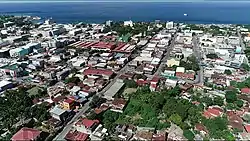 Skyline of Dumaguete in 2020 | |
 Flag  Seal | |
| Nickname: The City of Gentle People[1] | |
| Motto: Duma Get Me | |
 Map of Negros Oriental with Dumaguete highlighted | |
OpenStreetMap | |
.svg.png.webp) Dumaguete Location within the Philippines | |
| Coordinates: 9°18′37″N 123°18′29″E / 9.31028°N 123.30806°E | |
| Country | Philippines |
| Region | Central Visayas |
| Province | Negros Oriental |
| District | 2nd district |
| Cityhood | November 24, 1948 |
| Barangays | 30 (see Barangays) |
| Government | |
| • Type | Sangguniang Panlungsod |
| • Mayor | Felipe Antonio B. Remollo (LP) |
| • Vice Mayor | Ma. Isabel L. Sagarbarria (NPC) |
| • Representative | Manuel T. Sagarbarria (NPC) |
| • City Council | Members |
| • Electorate | 91,931 voters (2022) |
| Area | |
| • Total | 33.62 km2 (12.98 sq mi) |
| Elevation | 183 m (600 ft) |
| Highest elevation | 1,844 m (6,050 ft) |
| Lowest elevation | 0 m (0 ft) |
| Population (2020 census)[4] | |
| • Total | 134,103 |
| • Density | 4,000/km2 (10,000/sq mi) |
| • Households | 32,276 |
| Demonym(s) | Dumagueteño (masculine) Dumagueteña (feminine) |
| Economy | |
| • Income class | 2nd city income class |
| • Poverty incidence | 3.20 |
| • Revenue | ₱ 988.7 million (2020) |
| • Assets | ₱ 3,660 million (2020) |
| • Expenditure | ₱ 692.3 million (2020) |
| Service provider | |
| • Electricity | Negros Oriental 2 Electric Cooperative (NORECO 2) |
| • Water | Metro Pacific Dumaguete Water Services, Inc. (Metro Dumaguete Water) |
| Time zone | UTC+8 (PST) |
| ZIP code | 6200 |
| PSGC | |
| IDD : area code | +63 (0)35 |
| Native languages | Cebuano Magahat Tagalog |
| Website | www |
Dumaguete, officially the City of Dumaguete, and also known as Dumaguete City (Tagalog: [dʊmɐˈgɛtɛ]; Cebuano: Dakbayan sa Dumaguete; Filipino: Lungsod ng Dumaguete), is a 2nd income class component city and the capital of the province of Negros Oriental, Philippines. According to the 2020 census, it has a population of 134,103 people.[4] It is the smallest in terms of land area yet the most populous among the cities and municipalities in the province of Negros Oriental.
Dumaguete is a university city, with four large universities and a number of other colleges, attracting students of the province, as well as students of surrounding provinces and cities in Visayas and Mindanao. The city is best known for Silliman University, the first Protestant and American university in the country and in Asia.[6][7] There are also 18 public elementary schools and 8 public high schools.[1]
The power source of the city comes from the geothermal power plant in Palinpinon, Valencia.
Dumaguete is the core of one of the proposed metropolitan areas in the Philippines. Metro Dumaguete is proposed to included the component city of Dumaguete, as well as the towns of Bacong, Dauin, Santa Catalina, Siaton, Sibulan, Valencia and Zamboanguita.
Scholars have been pushing for the city's inclusion in the tentative list of the Philippines for future UNESCO World Heritage Site nomination.[8]
Etymology
"Dumaguete" was coined from the Cebuano word dagit, which means "to snatch". The word dumaguet, meaning "to swoop", was coined because of frequent raids by Moro pirates on this coastal community and its power to attract and keep visitors, both local and foreign. In 1572, Diego López Povedano indicated the place as Dananguet, but cartographer Pedro Murillo Velarde in 1734 already used the present name of Dumaguete for the settlement.[9]
History
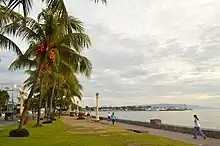
Kedatuan of Madja-as and Rajahnate of Cebu
Dumaguete city was once settled by Datus from Borneo that exiled themselves into the newly established Kedatuan of Madja-as,[10] it participated in the war against Chola occupied Odtojonan in Borneo as a constituent kingdom of the Kedatuan of Madja-as. Eventually, it fell under the aegis of the nearby Rajahnate of Cebu as the people of Dumaguete adopted Cebuano language, culture, and customs.[11]
Capital after division
The island of Negros was divided into the provinces of Negros Oriental and Negros Occidental by a royal decree executed by Governor General Valeriano Weyler on January 1, 1890. Dumaguete was made the first and only capital of the new Negros Oriental Province.
Philippine Revolution
During 1898, months after the arrival of Emilio Aguinaldo from exile, the Negros Revolution suddenly broke-out. Negros Occidental Province, which was still ruled by the Spanish authorities, eventually surrendered to the Negrense Revolutionary Forces after a battle on November 6. They then began a week-long march which captured Dumaguete on the 24th. By this time, the Spanish forces had left the entirety of Negros. The "Negros Republic" was then proclaimed on November 27.
American Era
The American era saw the allegiance of the Republic of Negros grow towards a collaborationist stance as a Pro-American Protectorate amidst the Philippine-American War. In sitiu, the Americans saw the people of Negros as more dependable allies compared to other Filipinos. Therefore, Dumaguete observed the establishment of Silliman University, the first American-founded University in Asia.[12][13][14]
World War II
Imperial Japanese forces landed at Dumaguete on May 26, 1942, after the fall of the Philippines, and all of Negros Oriental Province surrendered shortly thereafter. Resistance against the Japanese occupation continued by guerilla groups in the inner mountains, where many native residents had fled to. The local Negrense guerillas attacked the remaining Japanese officials and troops on August 6, 1945, and after their victory they welcomed combined American and Filipino forces that formally liberated Negros Oriental.
Cityhood
The City of Dumaguete was formally created on July 15, 1948, under Philippine Congressional Republic Act No. 327, also known as the "Charter of the City of Dumaguete". This was later amended on June 21, 1969, by Republic Act No. 5797, which clarified and refined the powers and functions of the local government unit in the earlier act.
Martial law
Journalist Crispin Maslog who was teaching at Silliman University at the time,[15] he notes that Dumaguete learned about Marcos' declaration of Martial Law earlier than other parts of the country did on September 23, 1972, because local news station DYSR was able to pick up the news from an Australian broadcast. Elsewhere in the country, media outlets such as newspapers and broadcast stations had already been shut down, but DSYR was able to make the announcement before Information Secretary Francisco Tatad did at around noon. DYSR itself would be shut down later that day.[15]
Maslog recounts that Silliman University in Dumaguete was one of the last four universities in the Philippines to be allowed to reopen for classes, with Marcos himself complaining about instances where members of the political opposition such as Senators Jovito Salonga, Juan Liwag were invited to speak at the University.[15]
In the mid 1980s, the crony capitalism which characterized the Martial Law administration had a major effect on the island of Negros in which Dumaguete is located.[16][17] A sugar hoarding scheme by National Sugar Trading Corporation (NASUTRA) of Roberto Benedicto backfired,[17] resulting in the mass-firing of sugar workers in Negros Oriental and Negros Occidental. Worsened by the economic nosedive which had begun in 1983, it eventually became known as the 1985 Negros famine.[17]

Geography and environment
Dumaguete has a land area of 3,362 hectares (8,310 acres), situated on the plains of the southeastern coast of the large island of Negros, near the mouth of the Banica River. Of the province's 19 municipalities/towns and 6 cities, Dumaguete is the smallest in terms of land area. It is bounded on the north by Sibulan, south by Bacong and west by Valencia.
As a coastal city, it is bounded on the east by the Bohol Sea and the Tañon Strait, serving as a natural border of the southeastern border of Negros Oriental. The city's topography is generally flat from two to six kilometers from the shoreline. It slopes gently upwards to the adjoining municipality of Valencia. The highest ground elevation is located at the boundary of the municipality of Valencia, about one hundred meters above mean sea level. About 93% of the land have slopes of less than 3%. The remaining areas have 3% to 5% slope.
Climate
| Climate data for Dumaguete (1991-2020, extremes 1910–2021) | |||||||||||||
|---|---|---|---|---|---|---|---|---|---|---|---|---|---|
| Month | Jan | Feb | Mar | Apr | May | Jun | Jul | Aug | Sep | Oct | Nov | Dec | Year |
| Record high °C (°F) | 33.7 (92.7) |
34.2 (93.6) |
34.2 (93.6) |
36.8 (98.2) |
36.2 (97.2) |
37.4 (99.3) |
36.6 (97.9) |
36.7 (98.1) |
37.0 (98.6) |
36.1 (97.0) |
34.7 (94.5) |
34.2 (93.6) |
37.4 (99.3) |
| Mean daily maximum °C (°F) | 29.2 (84.6) |
29.4 (84.9) |
30.2 (86.4) |
31.2 (88.2) |
31.9 (89.4) |
31.7 (89.1) |
31.5 (88.7) |
31.9 (89.4) |
31.7 (89.1) |
31.2 (88.2) |
30.7 (87.3) |
30.1 (86.2) |
30.9 (87.6) |
| Daily mean °C (°F) | 26.9 (80.4) |
26.9 (80.4) |
27.5 (81.5) |
28.3 (82.9) |
28.7 (83.7) |
28.4 (83.1) |
28.0 (82.4) |
28.2 (82.8) |
28.1 (82.6) |
27.9 (82.2) |
27.9 (82.2) |
27.6 (81.7) |
27.9 (82.2) |
| Mean daily minimum °C (°F) | 24.6 (76.3) |
24.5 (76.1) |
24.7 (76.5) |
25.4 (77.7) |
25.5 (77.9) |
25.0 (77.0) |
24.5 (76.1) |
24.4 (75.9) |
24.4 (75.9) |
24.6 (76.3) |
25.1 (77.2) |
25.0 (77.0) |
24.8 (76.6) |
| Record low °C (°F) | 19.3 (66.7) |
19.8 (67.6) |
19.6 (67.3) |
18.9 (66.0) |
20.7 (69.3) |
20.7 (69.3) |
19.8 (67.6) |
20.5 (68.9) |
18.0 (64.4) |
20.8 (69.4) |
20.4 (68.7) |
19.8 (67.6) |
18.0 (64.4) |
| Average rainfall mm (inches) | 96.7 (3.81) |
73.7 (2.90) |
68.2 (2.69) |
49.1 (1.93) |
84.5 (3.33) |
144.0 (5.67) |
146.0 (5.75) |
104.6 (4.12) |
116.8 (4.60) |
158.6 (6.24) |
146.4 (5.76) |
134.0 (5.28) |
1,322.6 (52.08) |
| Average rainy days (≥ 0.1 mm) | 11 | 8 | 7 | 5 | 8 | 12 | 14 | 11 | 12 | 13 | 11 | 12 | 124 |
| Average relative humidity (%) | 84 | 83 | 81 | 79 | 79 | 81 | 82 | 80 | 81 | 82 | 82 | 83 | 81 |
| Source: PAGASA[18][19] | |||||||||||||
Dumaguete has a tropical savannah climate, bordering a tropical monsoon climate according to the Köppen Climate classification with two distinct seasons: wet and dry. The wet season covers the period from June to November, and the dry season starts from December to May, the hottest being April and May. The average maximum temperature is 30.9 °C and the average minimum temperature is 24.8 °C for the 1991-2020 normals. The relative humidity of the locality for the past years was 81% with the month of January registering the highest.
Environment
Dumaguete has a rich and unique marine ecosystem that provides livelihoods to fishers[20] and supports tourism.[21] The coastal environment, which includes seagrass meadows, acts as efficient carbon sinks that mitigate the effects of climate change.[22] This ecosystem includes 36.15 hectares of seagrasses and 36.20 hectares of coral reef.[20] Dumaguete has four marine protected areas covering 104 hectares that host over 200 species of fish.[23][22]
The fragile marine ecosystem is under threat from a proposed 174 hectares (430 acres) reclamation project that is facing opposition from youth organizations, church groups, residents, and environmental scientists, including Philippine national scientist and former environmental secretary Angel Alcala.[24][23]
Barangays
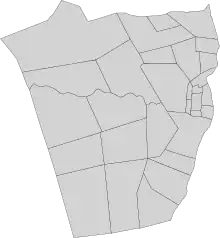
Dumaguete is politically subdivided into 30 barangays. Each barangay consists of puroks and some have sitios.
Most of the barangays are classified as urban. The eight poblacions comprise the city's downtown area, and are assigned by numbers. The smallest barangay is Poblacion 4 with an area of only 5.11 hectares, while the largest is Banilad with 362.71 hectares.
| PSGC | Barangay | Population | ±% p.a. | |||
|---|---|---|---|---|---|---|
| 2020[4] | 2010[25] | |||||
| 074610001 | Bagacay | 7.2% | 9,592 | 8,266 | 1.50% | |
| 074610002 | Bajumpandan | 5.9% | 7,880 | 4,500 | 5.76% | |
| 074610003 | Balugo | 3.1% | 4,110 | 2,980 | 3.27% | |
| 074610004 | Banilad | 7.2% | 9,664 | 8,286 | 1.55% | |
| 074610005 | Bantayan | 3.3% | 4,430 | 4,920 | −1.04% | |
| 074610006 | Batinguel | 7.4% | 9,965 | 8,148 | 2.03% | |
| 074610007 | Buñao | 2.0% | 2,723 | 2,727 | −0.01% | |
| 074610008 | Cadawinonan | 5.1% | 6,887 | 4,892 | 3.48% | |
| 074610009 | Calindagan | 5.0% | 6,709 | 8,056 | −1.81% | |
| 074610010 | Camanjac | 3.6% | 4,859 | 4,142 | 1.61% | |
| 074610011 | Candau-ay | 7.2% | 9,593 | 6,583 | 3.84% | |
| 074610012 | Cantil-e | 3.5% | 4,697 | 3,229 | 3.82% | |
| 074610013 | Daro | 4.6% | 6,164 | 6,373 | −0.33% | |
| 074610014 | Junob | 5.7% | 7,651 | 6,054 | 2.37% | |
| 074610015 | Looc | 3.0% | 4,063 | 4,058 | 0.01% | |
| 074610016 | Mangnao-Canal | 2.3% | 3,113 | 3,707 | −1.73% | |
| 074610017 | Motong | 1.8% | 2,429 | 2,137 | 1.29% | |
| 074610018 | Piapi | 3.6% | 4,842 | 6,149 | −2.36% | |
| 074610019 | Poblacion 1 (Tinago) | 1.6% | 2,141 | 2,170 | −0.13% | |
| 074610020 | Poblacion 2 | 0.8% | 1,055 | 1,305 | −2.10% | |
| 074610021 | Poblacion 3 | 0.1% | 193 | 150 | 2.55% | |
| 074610022 | Poblacion 4 | 0.2% | 225 | 218 | 0.32% | |
| 074610023 | Poblacion 5 | 0.1% | 142 | 132 | 0.73% | |
| 074610024 | Poblacion 6 | 0.2% | 255 | 325 | −2.40% | |
| 074610025 | Poblacion 7 | 0.1% | 175 | 202 | −1.42% | |
| 074610026 | Poblacion 8 | 1.2% | 1,569 | 2,363 | −4.01% | |
| 074610027 | Pulantubig | 2.2% | 2,994 | 3,266 | −0.87% | |
| 074610028 | Tabuctubig | 1.0% | 1,399 | 1,684 | −1.84% | |
| 074610029 | Taclobo | 7.1% | 9,458 | 9,691 | −0.24% | |
| 074610030 | Talay | 3.8% | 5,126 | 4,170 | 2.09% | |
| Total | 134,103 | 120,883 | 1.04% | |||
Demographics
| Year | Pop. | ±% p.a. |
|---|---|---|
| 1903 | 14,894 | — |
| 1918 | 16,336 | +0.62% |
| 1939 | 22,236 | +1.48% |
| 1948 | 24,838 | +1.24% |
| 1960 | 35,282 | +2.97% |
| 1970 | 52,000 | +3.95% |
| 1975 | 52,765 | +0.29% |
| 1980 | 63,411 | +3.74% |
| 1990 | 80,262 | +2.39% |
| 1995 | 92,637 | +2.72% |
| 2000 | 102,265 | +2.14% |
| 2007 | 116,392 | +1.80% |
| 2010 | 120,883 | +1.39% |
| 2015 | 131,377 | +1.60% |
| 2020 | 134,103 | +0.40% |
| Source: Philippine Statistics Authority[26][25][27][28] | ||
As of the census in 2015, there are 131,377 people and 21,582 households residing in the city (as of 2010). The city has the least poverty incidence among urban centers in Visayas, according to the 2009 Small Area Estimates (SAE) of Poverty done by the National Statistical Coordination Board (NSCB). It has an average daylight population of 400,000 people. Dumaguete is the most populous city in Negros Oriental, comprising 9.05% of the province's total population. Its total voting population is 89,193 voters (2019).
The Philippine Retirement Authority, a government agency under the Department of Tourism, has named the city as the "Best Place to Retire in the Philippines for 2018".[29] Dumaguete is also listed 5th in Forbes Magazine's "7 Best Places to Retire Around the World".[30]
Economy
Industries

Tourism, the academe, the retail industries, BPO and technology-related activities are the major sources of income of the city. BPOs and IT firms, as well as retailing, are the fastest rising industries. There are significant number of banking institutions and a branch of Bangko Sentral ng Pilipinas within its territory.
Business activities are mostly concentrated in the downtown area and bayside Rizal Boulevard with some prominent shopping centers such as Lee Super Plaza and Robinsons Townville Perdices but with the completion of 4 lanes circumferential highway known as Metro Dumaguete Diversion Road helps decongest the traffic in the main thoroughfares of Central Business District traversing from the town of Sibulan down to Bacong. The new highway is expected to economically benefit the outskirt barangays of the city as new growth centers with the opening of satellite market, South Bus Terminal, city satellite provincial hospital to name a few. These growing industries made Dumaguete the hub for shopping, education, financial, IT, commerce, lifestyle and sports in the province of Negros Oriental and region.
Real estate and infrastructure
The real estate industry in the city is also booming with a number of constructions such as condominiums, town centers and massive horizontal housing projects. New shopping centers such as Marina Town Mall by Filinvest Group, Bayshores Dumaguete and popular restaurants, bars and dining strips along Flores Avenue (North Boulevard) in the Piapi District have excellent views of Dumaguete Bay. Filinvest is on track to develop the beach area for another residential complex in the coastal barangay of Mangnao through its Futura Shores Dumaguete cluster of condominiums project. CityMall Dumaguete, a community mall owned by DoubleDragon Properties and homegrown Cang's Shopping Complex, is positioned along the national highway serving shoppers in the north. A Public Transport Terminal with multi-level parking spaces is being built at the back of Robinsons Place Dumaguete within the Dumaguete Business Park enclave. Joining the existing Dumaguete Business Park and Marina Town Center are the Lifestyle 8880 Commercial Complex at Daro, the E.C. Ouano Sr. Complex for the new location of government offices extending to the Camella Homes development site (township, condominium and commercial projects) in between Bajumpandan-Cantil-e areas and the proposed Brgy. Talay development center where chosen as the site of the new state-of-the-art City Hospital among the new growth centers of this city.
Business process outsourcing

Dumaguete's outsourcing industry has a range of businesses, such as call centers, publishing, medical transcription, animation, editing, and architectural outsourcing. Dumaguete is listed among Next Wave Cities in the country with over 20 IT and BPO locators, and has been described as a hub for Business Process Outsourcing and Information Technology.[38][39]
Cooperatives
DCCCO (Dumaguete Cathedral Credit Cooperative) and PHCCI (Perpetual Help Community Cooperative) are among the prominent cooperatives in the country which are both rooted in Dumaguete.
Tourism

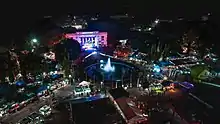
Data from the Department of Tourism show that Dumaguete, the province's main gateway, and Negros Oriental are listed among the top ten most visited tourist destinations in the country.[40]
Historical Landmarks
Rizal Boulevard is known for its sugar mansions and prominent ancestral houses that are now mostly converted into hotels, local-based and nationally known coffee shops, fine-dining restaurants and bars. The reclaimed Dumaguete People's Park is the newest attraction located at the south end of Rizal Boulevard. This area, so-called Pantawan by the locals, is extended up to the mouth of Banica River will have sand courts and shoreline protection for the coastal barangay of Poblacion 1 Tinago.
Bay walk is the popular site of both locals and visitors for relaxing, dining and doing morning or late afternoon exercises. Food carts installed beside the Pantawan area sell Filipino street food such as balut, tempura, kikiam, fishballs and the like. The boulevard extension to the north from the city's port (where the name changes to Flores Avenue and Escaño Drive) are now dotted with new hotels, resort, restaurants and bars, with views of the bay and neighboring islands such as Cebu, Sumilon, Bohol on a clear weather and another angle of Siquijor.
The St. Catherine of Alexandria Cathedral is known as the oldest stone church of Negros Island and the home of ecclesiastical seat of the bishop of Roman Catholic Diocese of Dumaguete. The detached Campanario of the cathedral is considered one of the oldest heritage landmarks of Dumaguete and Central Visayas. Meanwhile, Dumaguete Presidencia, the old City Hall, is being restored to its original design and is now the branch of the National Museum in Dumaguete. The cathedral, belfry, and museum are all located beside Quezon Park named after the Philippine first President of the Commonwealth, Manuel L. Quezon.
The Silliman Hall is home to the university's Anthropology Museum.
Festivals
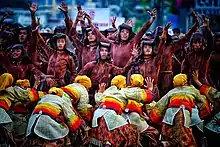
One of the cities' important annual celebrations is the Sandurot Festival, which is held every September to commemorate Dumaguete's history. The celebration starts with the Paghimamat, a re-enactment of how people from different ethnic and cultural backgrounds came to Dumaguete, bringing gifts of rich cultures. Pasigarbo follows, gracing the city streets with dancing to drumbeats and other instruments participated by different barangays and schools in Dumaguete. The street dancing ends at Quezon Park after which the participants prepare for the grand Pasundayag, a display of dances portraying different stories of the Dumaguete tradition.
Another important annual occasion is the Buglasan Festival, also known locally as the "Festival of all festivals", which is held in the whole Negros Oriental province every October since 2002. Though this is a province-wide event sponsored by the provincial government, the activities are mostly centered in the province's capital, Dumaguete. Majority of activities are held in the Provincial Capitol and Ninoy Aquino Freedom Park with booths and local products either on display or for sale. It is also spread to other venues such as the Sidlakan Negros Village at Barangay Piapi and the city's Rizal Boulevard. Showdowns and street dancing are among the activities done in observance of the festival.
Healthcare
Dumaguete has four major tertiary hospitals, namely the Holy Child Hospital (HCH), Negros Oriental Provincial Hospital, ACE Dumaguete Doctors Hospital and the Silliman University Medical Center which is currently associated with St. Luke's Medical Center in Metro Manila.[41] The Dumaguete Health Office is responsible for the implementation and planning of the health care programs provided by the city government, which also operates and supervises Health Centers in the barangays of the city.
Transportation
Air

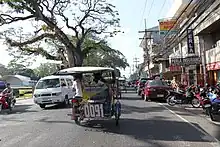
Sibulan Airport (IATA: DGT, ICAO: RPVD), also known as Dumaguete Airport or Dumaguete-Sibulan Airport, is the city's domestic airport located in neighboring Sibulan town in the north. It provides daily flights to and from Manila and Cebu City through Cebu Pacific, Cebgo and PAL Express while Cebgo is servicing both Mindanao important urban centers, thrice weekly flights to Davao City and Cagayan de Oro.[42] However, a new airport is being planned to be built in Bacong, a town bordering Dumaguete in the south.[43] The proposal for the transfer and upgrading of this airport to international standards has already been initially approved and should be completed before 2025. An initial PHP 500 million budget has already been released for initial study and procurement of free lands.[44] In March 2021, while awaiting for final approval of the construction of the new airport in Bacong, upgrade works were made to the current Sibulan Airport which include pavement reconstruction, expansion of the terminal building from 1,152sqm. to 1,842sqm., and expansion of CAAP administrative buildings.[45]
Sea
Dumaguete, as a major port city, is a jump-off point for passengers/tourists who are going to other Visayas and Mindanao areas. Currently, the port is equipped with two modern port operations and passenger terminal facilities. It is also the headquarters site of Coast Guard Station Negros Oriental under Philippine Coast Guard Central Visayas District.
As major point of Philippine Western Nautical Highway System, there are daily ferry connections to the islands of Cebu, Bohol, Siquijor and Mindanao operated by Archipelago Philippine Ferries Corporation (FastCat), Montenegro Lines, Medallion Transport, Ocean Jet Shipping, Lite Shipping, Cokaliong and other companies. Dumaguete is an access city for passengers/tourists going to Cebu City. Alternatively, there are smaller ports north of the city where short and frequent ferry connections mostly to Cebu Island are available. Dumaguete is a port of call for travelers to Manila, Dapitan and Zamboanga City by ship serviced by 2GO Travel.
Land
The main form of public transport in Dumaguete is the motorized tricycle. The Dumaguete version of the motorized tricycle can fit up to 6-8 passengers. For transport to destinations outside the city limit, there are jeepney and buses travelling set routes. Meanwhile, Vallacar Transit Corporation, the company that operates Ceres buses, recently constructed a 2-storey terminal building in Barangay Calindagan just beside the newly erected commercial center, the Marketplace. Buses from Dumaguete have routes going to Bacolod City/Negros Occidental, Cebu City/Cebu Province, Zamboanga City via Dipolog/Dapitan of Zamboanga Peninsula, Tagbilaran City/Bohol via Cebu and Cubao/Metro Manila using Western Nautical Highway. Dumaguete is 215 kilometres (134 mi) from Bacolod City via Kabankalan-Mabinay-Bais Road.
Sports
Dumaguete has hosted numerous Asian, national, regional and provincial sports events, such as the 4th Asian University Basketball Federation (AUBF) 2005, the 2013 Palarong Pambansa, 2012 Philippine National Games (POC-PSC), Philippine Volleyball League, National Frisbee Championship, Batang Pinoy Visayas, Dumaguete Dragon Boat Challenge, Unigames, CVIRAA, the Palarong NIR for short-lived Negros Island Region among others. The Don Mariano Perdices Memorial Coliseum hosted the 2010 Central Visayas Regional Athletic Meet and 2013 Palarong Pambansa that was located in Dumaguete. Its capacity was 25,000 people with rubberized track oval, main lobby, dormitory, and hostel. Beside it is the Olympic size swimming pool known as the Lorenzo G. Teves Memorial Aqua Center. The Lamberto Macias Sports Complex is an indoor arena located near the coliseum which can accommodate around 6,000 people.[46]
Education

Dumaguete is known as the "center of learning in the South," or a university city due to the presence of well-known universities. Public elementary and high schools including Dumaguete Science High School, the regional science high school of Central Visayas is governed by City Schools Division of DepEd Dumaguete City.
• Silliman University (SU, 1901) is the dominant institution of higher learning in Dumaguete, providing the city with a university town atmosphere. It is the first Protestant university in the country and the first American university in Asia. The 610,000 square metres (6,600,000 sq ft) campus is adjacent to and intermixed with the city's downtown district.[48] Some of its buildings have likewise been recognized as landmarks, including the Silliman Hall, Hibbard Hall, Katipunan Hall, the Luce Auditorium, and the Silliman Main Library (considered one of the biggest libraries in the Philippines).[1][49][50][51] CHED designated Center of Excellence for its Nursing, Teacher Education, Marine Science and Information Technology while Center of Development for its Anthropology, Biology, Accountancy and Medical Technology programs.
• Foundation University (FU, 1949) is a private non-sectarian university with its Main Campus located at Miciano Road, offering tertiary education programs, while the North Campus along Locsin Street is the home of Foundation Preparatory Academy for its basic education programs.
• Negros Oriental State University (NORSU, 1907) is the province's only state university, with two main campuses in the city. The Main Campus 1 is beside the Provincial Capitol building, while the Main Campus 2 is located in barangay Bajumpandan. It is the first academic institution in the country to offer BS Geothermal Engineering. CHED designated Center of Development for its Teacher Education program.
• St. Paul University Dumaguete (SPUD, 1904) is the first Saint Paul educational institution to be established in the Philippines by the Sisters of Saint Paul of Chartres (SPC) from France and second oldest Catholic university of Central Visayas. It is recognized by CHED as full autonomy status Higher Education Institution (HEI).
• Colegio de Santa Catalina de Alejandria (COSCA, 1959) run by Catholic Diocesan clergy is located beside the Dumaguete Cathedral Church. Formerly known as Dumaguete Cathedral College, it offers pre-school to college programs. Its flagship courses are Commerce/Business Administration, Criminology and Radiologic Technology.
• Metro Dumaguete College (MDC, 2002) is an academic institution with campus in Barangay Daro, offering Senior High School program, laddered TESDA accredited Technical Vocational programs and other 4-year college courses.
Notable people
Sister cities
Dumaguete has the following sister cities:
Local
International
Gallery
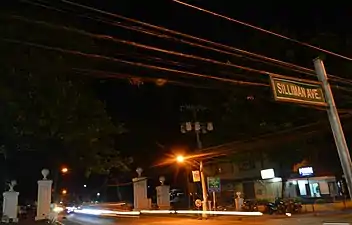 Silliman Avenue near the "Gate of Knowledge" of Silliman University
Silliman Avenue near the "Gate of Knowledge" of Silliman University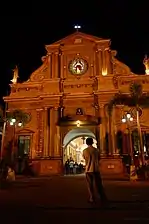
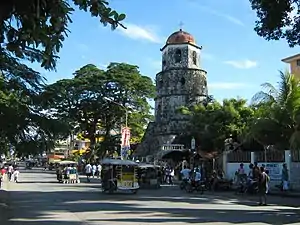 Dumaguete Belfry with grotto
Dumaguete Belfry with grotto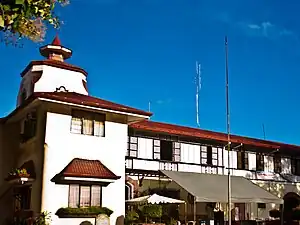 Dumaguete City Hall
Dumaguete City Hall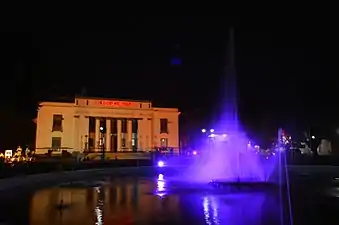 Provincial Capitol of Negros Oriental
Provincial Capitol of Negros Oriental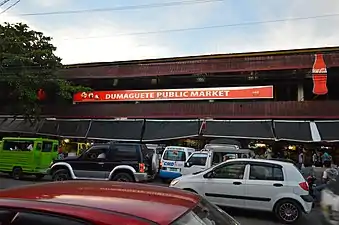 Dumaguete Public Market
Dumaguete Public Market The old "I Love Dumaguete" Sign previously situated at Rizal Boulevard
The old "I Love Dumaguete" Sign previously situated at Rizal Boulevard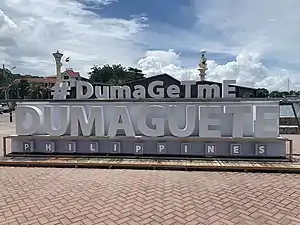 The popular "#DumaGetMe" Signage landmark located at Rizal Boulevard
The popular "#DumaGetMe" Signage landmark located at Rizal Boulevard
References
- 1 2 3 "Dumaguete City, the City of Gentle People". Department of Tourism. Retrieved November 4, 2010.
- ↑ City of Dumaguete | (DILG)
- ↑ "2015 Census of Population, Report No. 3 – Population, Land Area, and Population Density" (PDF). Philippine Statistics Authority. Quezon City, Philippines. August 2016. ISSN 0117-1453. Archived (PDF) from the original on May 25, 2021. Retrieved July 16, 2021.
- 1 2 3 Census of Population (2020). "Region VII (Central Visayas)". Total Population by Province, City, Municipality and Barangay. Philippine Statistics Authority. Retrieved 8 July 2021.
- ↑ "PSA Releases the 2018 Municipal and City Level Poverty Estimates". Philippine Statistics Authority. 15 December 2021. Retrieved 22 January 2022.
- ↑ "CSF program up in Dumaguete" Archived July 19, 2009, at the Wayback Machine. Manila Bulletin. By Atty. Ignacio Bunye. Posted July 5, 2009. Accessed October 14, 2009.
- ↑ "Heritage Diary of Negros Oriental". Inquirer.net. By: Dexter Matilla. Posted July 14, 2008. Accessed October 15, 2009.
- ↑ "Dumaguete City - Negros Oriental - Philippines". Archived from the original on September 26, 2010. Retrieved August 12, 2010. NegrosHub.com - Dumaguete City
- ↑ experiencephilippines.org
- ↑ Maragtas: The story of the life experienced by the datus of Borneo ... and their purchase of the island from King Marikudo, who was king of the Negritos, in the year 1520 (Pedro Alcantara Monteclaro ; Translated to English by Esther Abiera)
- ↑ "10 Fun Facts about Cagayan de Oro". About Cagayan de Oro. 5 February 2016. Retrieved 6 September 2018.
- ↑ "NHI Resolution No.7, Series 2002". National Historical Commission of the Philippines. Retrieved June 8, 2012.
- ↑ "Siliman University rocked by bomb threat; suspends classes". ph. news.yahoo.com. Retrieved November 12, 2019.
- ↑ spot.ph/arts-culture/the-latest-arts-culture/79241/silliman-university-dumaguete-a4329-20190928-lfrm "This School By the Sea Has Front-Row Seats to a Poetic Dumaguete Morning". SPOT.PH. Retrieved November 12, 2019.
{{cite web}}: Check|url=value (help) - 1 2 3 Maslog, Crispin (April 15, 2021). "'Probinsyano' remembers Martial Law". Rappler. Retrieved October 4, 2021.
- ↑ Reaves, Joseph A. (November 24, 1985). "SUGAR-CHOKED ISLAND STARVING". Chicago Tribune. Retrieved October 4, 2021.
- 1 2 3 Caña, Paul John (April 15, 2021). "Sugar Wars: Looking Back at the Negros Famine of the 1980s". Esquire Magazine Philippines. Archived from the original on April 15, 2021. Retrieved October 4, 2021.
- ↑ "Dumaguete City, Negros Oriental Climatological Normal Values" (PDF). Philippine Atmospheric, Geophysical and Astronomical Services Administration. Retrieved October 3, 2022.
- ↑ "Dumaguete City, Negros Oriental Climatological Extremes" (PDF). Philippine Atmospheric, Geophysical and Astronomical Services Administration. Retrieved October 3, 2022.
- 1 2 Manahan, Job (July 22, 2021). "Dumaguete reclamation to devastate nearby protected areas, marine biodiversity— conservation group". ABS-CBN News. Retrieved July 28, 2021.
- ↑ "Sustainability: WWF-Philippines: Dumaguete should choose the enlightened way forward in the service of life". Adobo Magazine Online. July 22, 2021. Retrieved July 28, 2021.
- 1 2 Cabico, Gaea Katreena (July 13, 2021). "Reclamation in Dumaguete seen to pose devastating impacts on environment, communities". Philstar. Retrieved July 28, 2021.
- 1 2 Bello, Raizza; Dagle, Robbin (July 11, 2021). "Environmental scientists, groups oppose Dumaguete 'smart city' reclamation project". Rappler. Retrieved July 28, 2021.
- ↑ "'An underwater tomb': Dumaguete reclamation would be a monumental ecological disaster - scientist". ABS-CBN News. July 16, 2021. Retrieved July 28, 2021.
- 1 2 Census of Population and Housing (2010). "Region VII (Central Visayas)" (PDF). Total Population by Province, City, Municipality and Barangay. National Statistics Office. Retrieved 29 June 2016.
- ↑ Census of Population (2015). "Region VII (Central Visayas)". Total Population by Province, City, Municipality and Barangay. Philippine Statistics Authority. Retrieved 20 June 2016.
- ↑ Censuses of Population (1903–2007). "Region VII (Central Visayas)". Table 1. Population Enumerated in Various Censuses by Province/Highly Urbanized City: 1903 to 2007. National Statistics Office.
{{cite encyclopedia}}: CS1 maint: numeric names: authors list (link) - ↑ "Province of". Municipality Population Data. Local Water Utilities Administration Research Division. Retrieved 17 December 2016.
- ↑ "Dumaguete City cited best PH place to retire". Philippine Information Agency.
- ↑ Dumaguete among 7 best places to retire, according to Forbes Magazine. GMA Network. November 15, 2014.
- ↑ "Poverty incidence (PI):". Philippine Statistics Authority. Retrieved December 28, 2020.
- ↑ "Estimation of Local Poverty in the Philippines" (PDF). Philippine Statistics Authority. 29 November 2005.
- ↑ "2003 City and Municipal Level Poverty Estimates" (PDF). Philippine Statistics Authority. 23 March 2009.
- ↑ "City and Municipal Level Poverty Estimates; 2006 and 2009" (PDF). Philippine Statistics Authority. 3 August 2012.
- ↑ "2012 Municipal and City Level Poverty Estimates" (PDF). Philippine Statistics Authority. 31 May 2016.
- ↑ "Municipal and City Level Small Area Poverty Estimates; 2009, 2012 and 2015". Philippine Statistics Authority. 10 July 2019.
- ↑ "PSA Releases the 2018 Municipal and City Level Poverty Estimates". Philippine Statistics Authority. 15 December 2021. Retrieved 22 January 2022.
- ↑ Baguio, Dumaguete now in top 10 BPO Next Wave Cities
- ↑ "Business - Small city hits big league in BPO trade - INQUIRER.net". Philippine Daily Inquirer. Archived from the original on April 2, 2015. Retrieved March 29, 2015.
- ↑ Top Tourist Destinations in the Philippines Archived September 9, 2010, at the Wayback Machine
- ↑ "St. Luke's inks MOA with Silliman Medical Center" Archived January 31, 2013, at archive.today. Philstar.com. Retrieved April 28, 2010.
- ↑ "CEB adds 2nd daily frequency to Manila-Dumaguete " Archived June 18, 2011, at the Wayback Machine. Cebu Pacific. Retrieved November 4, 2010.
- ↑ Partlow, Judy Flores (November 19, 2014). "To a new site in Bacong town Solon wants to relocate airport from Dumaguete". Archived from the original on December 14, 2014. Retrieved September 29, 2021.
- ↑ Master Plan for Philippine Airports
- ↑ "THE MUCH-IMPROVED AIRPORT OF DUMAGUETE!". Department of Transportation. March 11, 2021.
- ↑ "Venues -".
- ↑ "Dumaguete, Negros Oriental". Philippine Airlines. Retrieved September 1, 2010.
- ↑ UP is No.1 based on PRC exams Archived February 7, 2012, at the Wayback Machine. UP Newsletter, Vol. XXVIII, No. 09. September 1, 2007. Accessed May 26, 2009.
- ↑ Philippine Travel Center: Negros Oriental. Accessed September 1, 2009.
- ↑ Negros Chronicle. Where to go in Negros Oriental Archived May 27, 2016, at the Wayback Machine. Accessed September 1, 2009.
- ↑ WOWPhilippines: Things to do and see in Negros Oriental. Accessed September 1, 2009.



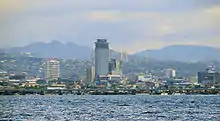
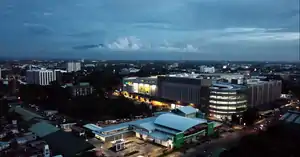

.jpg.webp)